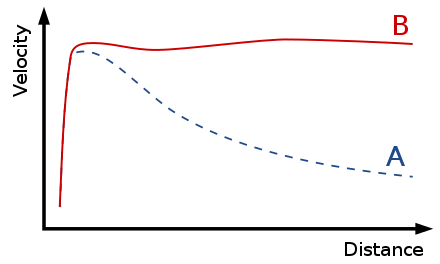Now, what makes us think dark matter is there if we can't see it? The idea arose from a disconnect between the amount of mass needed to account for things like the speeds of stars in galaxies using the laws of Newton and Kepler, and the mass actually producing light.
This notion that there must be mass that we can't see based on dynamics actually goes back over a century, with Lord Kelvin actually making some relevant calculations back in 1906! But we start this discussion with the work of the late, great Dr. Vera Rubin in the 1970s.
Using Kepler's laws for orbits, as you get away from the center of a spiral galaxy where the (normal light-producing, or "baryonic", but I'll just say normal) mass is concentrated, gravity should weaken and stars should orbit more slowly. Well....funny story.
Rubin examined rotation curves for spiral galaxies and found unlike the prediction (A), the real curves level out and the stars maintain their speeds regardless of distance (B)! Again applying Kepler, this means gravity must not weaken as we thought, so there must be more mass.
One more thing to point out with the big discrepancy in what we call the mass-to-light ratio is that as you get farther out you need MORE mass to make up for the difference between curves A and B. This is one way we conclude that DM is concentrated on the outskirts of galaxies.
These clumps of dark matter surrounding galaxies are called dark matter haloes, and we're gonna talk about them a LOT this week so get comfy! Be back later to give you other compelling evidence for DM!!
PS: the telescope formerly known as the Large Synoptic Survey Telescope is now the Vera C. Rubin Observatory and is under construction in Chile and I seriously can't imagine a better namesake.

 Read on Twitter
Read on Twitter


